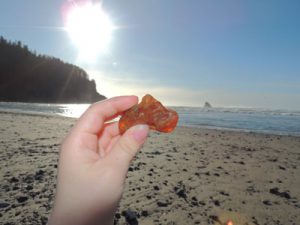Tillamook Coast Life Blog
5 Tips for Rockhounding on the Oregon Coast

My family has enjoyed rockhounding on Oregon’s Tillamook Coast for more than 30 years. Rockhounding is a fun and, in our family, oftentimes competitive pastime. With collections of red carnelian agates; white cloud or moonstone agates; and red, green or yellow jasper, our family beach home is decorated with these stones.
Rockhounding is not all that easy; however, so I’ve collected some tips to point you and your family in the right direction.
1. Safety
Safety is paramount on the Oregon Coast. While you may get engrossed in searching the beaches for treasures, you must always remain vigilant and never turn your back to the ocean. Sneaker waves are real, so remain alert with an awareness of the waves while simultaneously scouring the rock beds for treasures. Read up on safety.
2. Keep your eyes focused on the rocks in front of you
It’s easy to let your curiosity get the best of you, to raise your eyesight and start looking farther ahead in the beds, but based on my experience, your best finds are often right underfoot. Patiently scan the rocks in front of and around you, as special finds are within reach.
3. Find beaches with exposed beds
Beds of agates are present on the Tillamook Coast beaches year-‘round; however, they are not always visible, as most of the time they remain covered by a few inches to several feet of sand. Only the forces of nature can uncover these beds and we cannot predict when the beds will be exposed. In most cases, rock beds will be exposed in the winter, which is when our family happened upon a beach rich with beautiful agates.
4. Hunt the outgoing tide
Visiting the beach on an outgoing tide is the safest practice. Outgoing tides have their benefits for rockhounders, too. First and foremost, the rock beds have recently been covered in water, so the wet rocks glisten in the daylight and the special ones are easier for your eye to spot.
The outgoing tide actively agitates the rock bed, exposing a fresh supply of agates as each wave recedes. According to the Agates of the Oregon Coast pocket guide, “The most successful Agate hunter is the one who haunts the beaches on the out-running tides from December through March.”

5. Know what you’re looking for
Moonstone agates are a beautifully clear stone that you can hold up to the sun and see light through (translucent). Keep in mind that agates have varying degrees of translucency. In fact, jaspers are considered agates, yet they are opaque stones that come in red, green, yellow and brown.
My personal favorite is the brilliant, translucent carnelian agate, which is easy to find because the orange red stones stand out among the other neutral-colored rocks in the beds!
Where to go rockhounding on the Oregon Coast
The southern Tillamook Coast is known for its thick rock beds that surface every now and again. Beaches in Pacific City, Tierra Del Mar, Netarts Spit, Oceanside and Rockaway are also good bets. My family’s favorite agate-hunting beach is what we call the “secret cove” or “agate beach,” also known as Short Beach, north of Oceanside and sometimes difficult to access if nearby roads are closed. Good luck rockhounding! Plan your trip today at Tillamook Coast.


